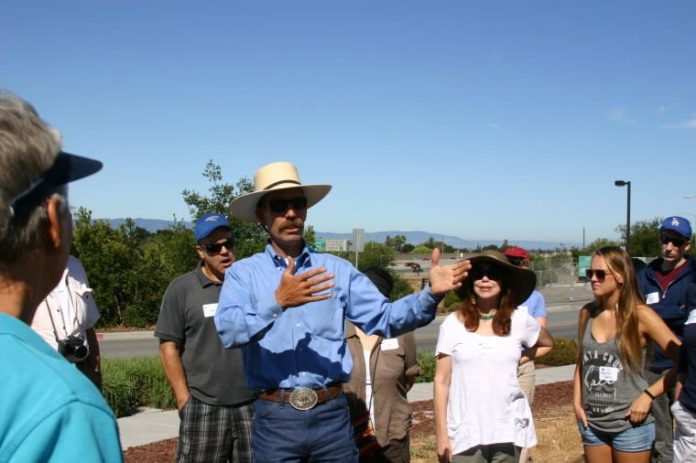What’s so cool about mother cows, baby crawfords, mottled javas and Frantoio olives?
Last weekend, more than 40 South County are residents got their answer during the all-day Harvesting Opportunity Farm Tour organized by the Committee for Green Foothills. CGF advocates for open space preservation, sound land-use policies and plans through education and outreach.
The idea that farming and ranching are not only central to South County’s history but also to its future was reinforced by Farm Tour speakers from all walks of life, including owners, operators and nonprofit advocates of local farming and ranching operations.
According to Julie Hutcheson, a CGF Environmental Advocate, “We believe in protecting resources through sensible development. There’s a lot of work to do with 50 percent of Santa Clara County farmland at risk. Planning for agriculture must be considered just as much as planning for cities.”
Here is a look at some of the movers and shakers keeping Santa Clara County’s agricultural profile alive and thriving.
Justin Fields is a modern-day cattle rancher whose family began ranching in the 1860s in the South San Jose and Coyote Valley.
His grass-fed beef cattle graze on family-owned and leased lands that include private ranches and land owned by the Santa Clara County Open Space Authority and County Parks. His grazing management practices align with landowner requirements and protect sensitive habitats, some of which are home to endangered species such as the Bay Checkerspot butterfly. Without cattle grazing, the butterfly’s natural plant habitat would quickly be overgrown by other species.
For Fields, who is President of the Santa Clara County Cattlemen’s Association, building long-term relationships with other stakeholders is important.
“I deal with multiple public agencies and private landowners. People appreciate the fact that I work to protect the land, and I am one of the few local ranchers in the area,” he says. “If something comes up, I’m here to deal with it right away.”
Andy’s Orchard
Andy Mariani guided Farm Tour visitors through his artisanal fruit farm where visitors sampled premium and heirloom cherries, nectarines, apricots, plums, pluots and the Orchard’s popular Baby Crawford peach, sought after by fruit connoisseurs for its classic flavor.
Mariani describes his Blenheim apricots as “a persnickety fruit that reaches near-perfection in local climate and soil. The fruit comes in all at once. You have to work fast or it’s all going to end up on the ground.”
Fruit that is not sold fresh is hand-cut and dried on large trays in an open-air drying shed. Mariani practices Integrated Pest Management and Good Farming Practices to minimize environmental footprint and ensure food safety.
“With mass production, growers focus on ship-ability and cold storage rather than taste,” he says. “We focus on specialty tree-ripened fruit with optimal sugar content, flavor, texture and juiciness. We harvest four to five times per season, picking just the fruit that is immediately ready.”
Andy’s Orchard also offers dried fruit and chocolate-covered fruits, jams and gelato.
1615 Half Road, Morgan Hill (408) 782.1393; www.andysorchard.com
Shady Creek Farm
Liza Garibaldi and Dave Clapp welcomed Farm Tour visitors to their small farming operation, which includes chickens, goats, alpacas, sheep, bee hives and vegetables. The couple has also created an educational series on homesteading basics, and participates in a local neighborhood co-op to exchange information, advice and services. Shady Creek now offers fresh eggs, and thanks to help from Uvas Gold Apiary of Gilroy, fresh honey. (www.uvasgold.com).
“There’s a lot you can do in your own back yard, and a lot of local resources to help you be successful,” said Garibaldi.
Also on hand was Susan Gallo, who has helped Shady Creek and neighboring farms get started with chicken farming. On her five-acre Morgan Hill farm, Gallo raises pastured mottled javas, an endangered breed of American heritage chickens. Gallo is a member of the Sustainable Poultry Network and the California State Council of the Center for Poultry.
14490 Watsonville Road, Morgan Hill (510) 854-6301; www.shadycreekfarm.com.
Frantoio Grove
Jeff and Pam Martin welcomed Farm Tour visitors to their 3,500-tree olive grove, situated on 30 acres destined to become open space land. It is the only Santa Clara County olive grove dedicated to the Frantoio olive.
“Rather than trying to compete with high-volume producers of canned olives, we chose the Frantoio and focused on making extra virgin olive oil,” said Jeff. “Frantoio has a distinctive flavor profile; complex and fruity with a hint of pepper and great balance.”
Tour guests sampled grilled bread brushed with Frantoio Grove Extra Virgin Olive Oil, a 2013 gold medal winner in the Los Angeles International, California Olive Oil Council, and Yolo and Napa Country olive oil competitions.
The Martin’s olives are hand-picked and then milled using water in a centrifuge. Milling transforms the olives into a paste, and separates the olive oil from the paste through several rinse and spin cycles. The presence of polyphenols in extra virgin olive oil is commonly associated with heart-healthy nutrition.
7888 Wren Ave B-120, Gilroy (408) 391-0013; http://www.frantoiogrove.com
Santa Clara County Open Space Authority (OSA)
During the Farm Tour lunch break, OSA General Manager Andrea Mackenzie summarized her organization’s Conservation Vision for Santa Clara County water, wildlife and working lands.
“We’re losing prime farmland in the county,” she said. “We need to think big, counter this trend and pick up the pace of conservation. Public and private partnerships are key.”
OSA is looking at high priority ag lands and ranch lands, and aims to increase awareness of the variety of services these landowners and users are providing to the community. Mackenzie said that nature has “economic value, a return on investment that isn’t being recognized,” and called for “healthy ecosystems at the heart of our communities, not on the fringes.”
Retired Santa Clara County planner Eric Carruthers pointed out that a growing number of small farmers are successfully farming and selling fresh fruits and vegetables into regional niches; restaurants, markets and even Kaiser Permanente. The healthcare group has a program with 19 hospitals buying produce from local small farmers.
“The survival of small farms here in South County is a matter of community will,” Carruthers noted.
Gilroy geologist Susan Meyer and Executive Director of Gilroy’s Loma Prieta Resource Conservation District added that there are “some very effective organizations in the Bay Area and South County, and some very smart farmers and ranchers who are solving complex problems together to the benefit of the environment and the people.”
OSA plans to publish a draft of its Conservation Vision for public review later this year. To get project information and give feedback, visit www.cvw3.org.
6980 Santa Teresa Blvd., San Jose CA (408) 224-7476, www.openspaceauthority.org.













